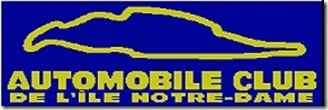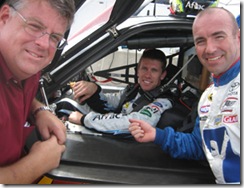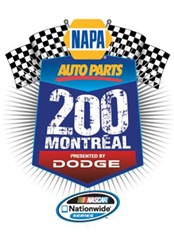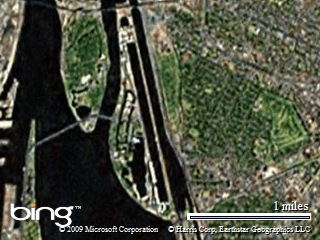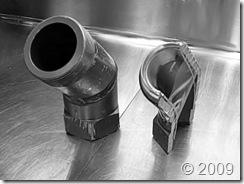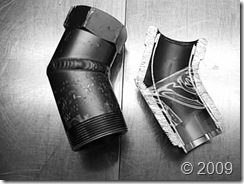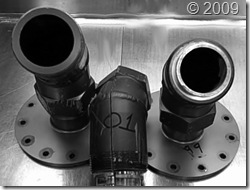PORSCHE GONE?
“I’d rather be the hammer than the nail, yes I would, if I could, I surely would” (performed by Simon and Garfunkel; lyrics by Paul Simon; arrangement by Daniel Alomias Robles)
Rumors of Porsche’s factory involvement departure from the Rolex Series at the conclusion of the 2009 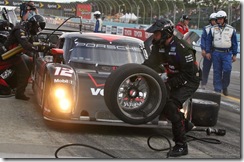 season, if true, shouldn’t really come as a big surprise for a number of reasons, not the least of which is the German manufacturer’s inability, through Penske Racing, to field a competitive car.
season, if true, shouldn’t really come as a big surprise for a number of reasons, not the least of which is the German manufacturer’s inability, through Penske Racing, to field a competitive car.
No, make that “field a car no one else can beat, except in the rarest of circumstances, such as global nuclear annihilation, in which case none wins.”
From race podiums to media centers, it’s Porsche’s nature to strictly control its brand, even to the point of calling a spade a non-spade or, particularly elsewhere in an earlier time, claiming a particular team didn’t have a factory advantage even though everyone in the corresponding paddock knew otherwise.
The Rolex Sports Car Series presented Crown Royal Cask No. 16 is a strange creature in the world of sportscar racing in that most anyone can effectively compete for a podium. Porsche doesn’t like such an uncontrollable idea and thus may well take its toys and go home. Should it, the Rolex Series will survive.
WHEN WINNING ISN’T NECESSARILY A GOOD THING
Watkins Glen Crown Royal 250 winner Krohn Racing withdrew from Saturday’s race at Circuit Gilles Villeneuve, obliquely citing legal “issues” with race car manufacturer Lola, whose badge graces two Krohn Racing cars but which, according to those in the know, has had little to do with the car’s success since the car’s introduction at the second race of the Rolex Series’ 2008 season.
Krohn Racing and Lola, working in a collaborative 2007 effort now known as “Proto-Auto LLC” after all-but-dormant Daytona Prototype manufacturing rights were secured from Multimatic, spawned a “second-generation” DP that was a hassle from the get-go as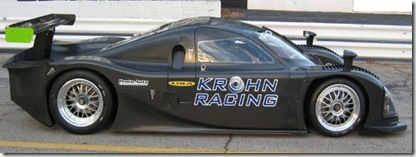 exasperated Lola designers saw multiple early designs and individual design elements repeatedly rejected by officials overseeing the Grand-Am DP project.
exasperated Lola designers saw multiple early designs and individual design elements repeatedly rejected by officials overseeing the Grand-Am DP project.
“They (Lola) just couldn’t get it through their heads that we weren’t going to allow them to build whatever they wanted to build,” one Grand-Am official said at the time while additionally pointing out that Lola’s 2007 design project had produced two, three-inch, three-ring binders thick with material - rejected and accepted renderings together - that juxtaposed with Riley Technologies’ second-generation DP work was about 10-times as voluminous.
A competing DP designer in early 2008 recalled fielding a call from an exasperated Lola engineer who in the summer of 2007, and well into the design-process window, wondered aloud as to “what one must do so as to submit an acceptable design.”
“Use proper minimums,” he said the Lola engineer was bluntly told.
“This was Lola’s first go with anyone having a NASCAR mindset and he just couldn’t fathom that Grand-Am wasn’t going to change their rules just so that they (Rolex Series) could point at a Lola on the grid. Lola wanted special exceptions for being Lola. Frankly, I rested as well that night as I had in months because it was the first firm indication that Lola wasn’t going to get whatever it desired when I thought it would, easily.”
The competing engineer also contended that Lola’s initial intransigence led to the design’s eventual inefficiencies.
“Time was running out and they had to submit something. With a deadline on the calendar they didn’t have another year to lollygag about and that’s what they got,” he said while sweeping his hand toward a Krohn Racing car, “a big, green paperweight.”
In an impromptu Aug. 7 Rolex Series Watkins Glen paddock discussion, a well-placed Krohn Racing insider cited to a reporter a number of efforts it had undertaken to take the car from “paperweight” to winning.
“All done without Lola’s help,” he said. “Not one thing have they done to help us this year. They’ve fought us at just about every juncture, including the cost (to end users) of parts.”
The company insider went on to say that negotiations to bring Proto-Auto “solely under our roof appear to be nearing an end and I think you’ll soon be hearing a positive announcement to that effect.”
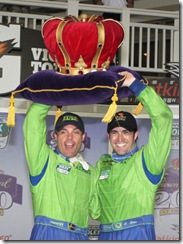 Remembering Krohn Racing’s earlier-2009 runaway win (by Rolex Series standards) at New Jersey Motorsports Park, the reporter suggested Krohn Racing might not wish to win any other races until the matter was settled.
Remembering Krohn Racing’s earlier-2009 runaway win (by Rolex Series standards) at New Jersey Motorsports Park, the reporter suggested Krohn Racing might not wish to win any other races until the matter was settled.
“Otherwise, Lola might not be willing to part with its piece of a pie that will grow more desirable as a result,” the reporter said.
A few hours later, Krohn Racing’s Nic Jonsson and Ricardo Zonta (pictured at left, left to right, respectively) won the Crown Royal race, in the process scoring the series’ third-largest margin of victory – 3.325 seconds – thus far in the 2009 season.
Though along with the Montreal withdrawal announcement Krohn expressed optimism about an early return to Rolex Series racing (the team “will continue testing”), the mere mention of legal proceedings makes one think it might well be 2010 before Krohn Racing returns. The really bad news? Other DP teams were taking a hard look at acquiring the Proto-Auto car, with one reportedly signed.
DOES ANYONE BELIEVE INDY ISN’T ON 2010 ROLEX SCHEDULE?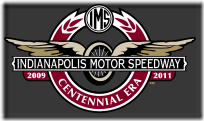
After this weekend’s Montreal event the next stop for 10 Rolex Series teams will be Indianapolis Motor Speedway (IMS) and a one-day Sept. 3 test of two IMS track configurations: the 2.621-mile (4.218-km), 16-turn (10 left, six right) counterclockwise-running MotoGP track (opened in 2008); and, the clockwise,13-turn (nine right, four left), 2.607-mile (4.195-km) former F1 track used for the United States Grand Prix during the 2000 through 2007 seasons. Each configuration uses about one mile of the oval’s layout.
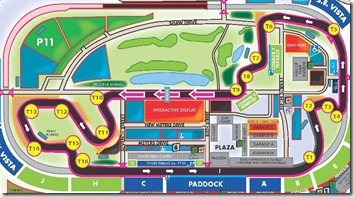
The MotoGP circuit, at left, gets the morning workout; the very similar (just take out MotoGP’s Turns 1, 2, 3, 4 and replace with nearby oval portion) but opposite-running F1 track gets the afternoon test. Or, maybe, it’s the other way around.
Whatever, opened in 1909, the 2.5-mile oval has since had multiple surfaces ranging from crushed stones (mixed with tar), to bricks, tarmac and asphalt. The effect of the present asphalt surface, the one which ground Good Year’s 2008 NASCAR Sprint Cup tires to dust, is one of the questions to be answered at the test.
The track eventually also built its way to roughly 250,000 permanent seats, making it the largest motorsports facility in the world. IMS approaches its maximum capacity, from paddock to grandstands, for its annual IndyCar Series Indy 500 and the NASCAR Sprint Cup Allstate 400. The 225,000 attendees for the 2002 United States Grand Prix is believed the largest turnout ever for a Formula One race.
Humans don’t understand what they don’t know. The reason for the preceding profound statement is the almost mind-blowing process used to convert the 2.5-mile IMS oval to a road course, some of which includes:
- Crews moving temporary inside walls and catch fencing at points where the road course enters and exits the oval
- Install tire barriers for the road course’s Turns 1 and 12 (F1 configuration), as well as other areas, in the process moving approximately 10,000 of IMS’ roughly 24,000 tires for various road course safety features
- Closure of several infield roads along with erecting concrete and tire barriers that help define the road course’s infield portions
- Moving 60 6-ton and 60 4-ton concrete barriers used in various locations on the circuit.
The above is just a smidgeon of what must be undertaken as between 12,000 and 17,000 man-hours are expended in turning the traditionally configured Brickyard into a road course.
In short, IMS is something other than your mother’s local bull ring - and it even has a golf course that this humble (repeatedly humbled?) golfer will someday get to play before driving into the Great Fairway in the sky.
When the five DP and five GT teams (described below) take to the IMS track it’ll mark the culmination of a route whose test at first was super secret but now has become a tool to measure “overall reaction from our participants, fans and media,” according to Grand-Am president Roger Edmondson.
The originally intended mid-August test (note that it was a couple weeks-or-so after NASCAR Sprint Cup Series’ Brickyard 400) was supposed to include at least two NASCAR Sprint Cup cars (one being out of the Richard Childress Racing shops) but, for some reason (probably because the Good Year Indy tires actually allowed the Sprint Cup cars to kinda, sorta race this year), the Cup cars were dropped from the rescheduled Sept. 3 test (which doesn’t mean they won’t eventually hold a test, BTW).
Rolex Series teams invited to the IMS test (assuming all is well following this weekend’s action at Circuit Gilles Villeneuve) include Daytona Prototypes No. 01 TELMEX Lexus-Riley'; No. 99 GAINSCO Pontiac-Riley; No. 10 SunTrust Ford-Dallara; No. 6 Pew Sailing Ford-Riley; and, the No. 90 AMA Pro Racing Porsche Cayenne-Coyote.
A full driver list for the test, as of the time this is written, has yet to be released but the grapevine has Mike Shank fulfilling a lifelong dream to drive a race car at IMS. However, one would expect the Rolex Series to undertake some sort of initiative to get those names into the public domain if the test truly is a means by which to gauge “overall reaction.”
Grand Touring teams expected are the No. 87 Farnbacher Loles Racing Porsche GT3; No. 07 Drinkin' Mate Pontiac GXP.R; No. 57 BryanMark Financial Pontiac GXP.R; and, the No. 70 SpeedSource Castrol Syntec Mazda RX-8.
As an aside, one recently got the feeling that NASCAR blamed its sportscar side for leaking the secret Aug. 18 test. While such could be true, Charlotte stockcar-side personnel nonetheless were buzzing with the news shortly after the first date was mentioned.
When one considers the effort undertaken for this test, one can’t help but believe the Rolex Series will be at IMS in 2010 unless some catastrophic flaw arises at the test – which would likely only delay an inevitable IMS Rolex Series race.
LISTEN IN
Learn if Mike Shank really is going to test the No. 6 MSR Ford-Riley at Indy. Besides Shank, tonight’s guests on Grand-Am Weekly are Brendan Gaughan and Andrew Davis - who with co-driver Robin Liddell won the 2008 Montreal GT race in the No. 57 BryanMark Financial Pontiac. Perhaps Davis will reveal if he, too, will test at Indy on Sept. 3. Join JJ O’Malley, producer Wyatt Davis and yours truly from 7:05 p.m. (following ABC national news) to 8 p.m. EDT Tuesday on WELE 1380 AM Sports Radio – get LIVE Web stream by clicking here!
Later,
DC






